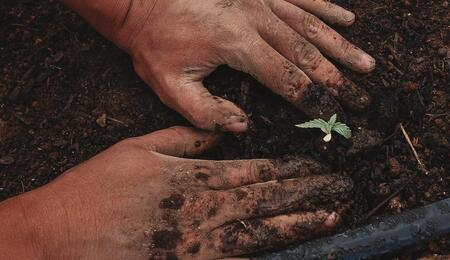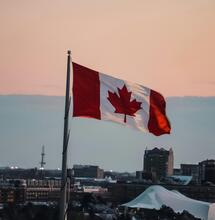California: The Green Rush Transforms Desolate Land in the Desert

It seems there isn't a corner in the U.S. that the booming cannabis industry hasn't touched. Come investment, the Green Rush transforms even the most desolate spots on earth, such as the California desert. The desert has offered cannabis companies something other areas can't: the freedom and space to grow.
Off from a dusty stretch of highway in California's Coachella Valley, Desert Hot Springs was merely a sluggish retirement community sleeping in the shadows of its more charming neighbour on the south, Palm Spring. However, this has started to change rapidly, all thanks to the Green Rush. The local government has been friendly to investors who want to capitalise on cannabis. According to Desert Hot Springs mayor Scott Matas, the industry contributed over $4 million to city revenue last year. It's a sum that surpasses revenue from other sectors, such as real estate, featherlight. For a city that has twice faced bankruptcy within the last 20 years as there was virtually no money on its accounts, cashing in from the cannabis industry has brought it back from the dead. Matas, who is now running his third term as a Mayor, remembers when back in 2011, the city had as little as "$400 in the bank," he told NBC News. During the 1940s and 1950s, the local economy blossomed with the set up of over 200 spas fed by a natural underground aquifer, which still provides water for much of the Coachella Valley. But spa business has since dwindled. And it was not until the recent meddle of the cannabis sector that things finally moved on the bright side.
The Cannabis Sector Has Changed Everything
From empty banking accounts to making millions, the cannabis industry has proven to be a real game-changer for a small place like Desert Hot Springs. Deputy City Manager Doria Wilms has told NBC News, "it's been incredible to see the transformation. We don't see it slowing down." One of the companies that have expanded in the area is Gold Flora, an operator with various products that range from premium vape pens to packaged flowers. CEO Laure Holcomb runs the company, and she is already in command of large-scale operations in the desert city.
Growing cannabis in the desert requires latest technology and recycling all of the available resources to make the most of it.
Gold Flora cultivation capacities entail taking care of over 9,000 cannabis plants, shielded from the scorching desert sun with insulated metal panel facilities. Even without the air conditioning, temperatures inside the building could never breach 80 degrees (27°C) despite the hot outside. Plants are stored atop rolling benches that rely on an internal irrigation system to water crops individually, according to NBC News. Gold Flora has a total of five warehouse-size buildings, some of which are rented to other cannabis operators. Everything in the vast campus the company owns was built from scratch. "Most people, when they think about the desert, they think they're going out in the middle of nowhere," Holcomb told NBC News. "It made sense that if you build it, they will come." Greg Gamet, Chief Cannabis and Operations Officer at Gold Flora, said in a statement last year when the company entered an advanced construction phase at their Desert Hot Springs location that "this project has been a dream." "We've been able to work with top architects, engineers, and construction crews, and now we are thrilled to be operating in this state-of-the-art facility," Gamet said. "We built a facility that is somewhat of a cultivator's dream – with all the bells and whistles. The technology in this facility, combined with our long history as cultivators of award-winning strains, will allow us to produce the finest quality products possible," he said. With constant sun and almost no rain, cultivating cannabis in the desert requires behemoth amounts of water and electricity to keep indoor operations going when outside temperatures reach record three digits. Kings Garden, another cannabis operator that produces about 40,000 pounds of cannabis flower annually, relies on a water filtration technology similar to municipal systems use. This operator has a design that recycles and reclaims its water supply, generating about 70 per cent of what it needs internally. The rest comes from the municipal water district. Water that cannot be repurposed for cultivating cannabis is rerouted to local farmers for use on seasonal crops.
Gold Flora and Kings Garden are just two of the growing number of cannabis operators present in the Coachella Valley small town.
Even though it has cost fortunes to set up proper facilities to cultivate cannabis in a desert environment, investments have paid off. Gold Flora, Kings Garden, and other companies present in the valley have represented a major boost for the local economy. According to NBC News, the tax revenue from cannabis businesses has already helped Desert Hot Springs pay for a new City Hall, a library, roads, and more police officers. Like a domino effect, industrial development has also triggered the interest of housing developers. And in terms of jobs, Wilms said that of the 29,000 residents of Desert Hot Springs, over 2,300 are now employed in the cannabis sector.
It All Started Before Recreational Pot Was Legal
With an unprecedented economic meltdown, city officials didn't have much to lose when they opened up for business with cannabis operators. At the time, only medical cannabis was legal in California. The U.S. state wrote history by being the first to introduce legislation on medical cannabis in the 1990s, but recreational legalisation had to wait until 2016. Nevertheless, when in 2014 Desert Hot Springs became the first city in Southern California to green-lit large-scale medical cannabis cultivation, the potential was already huge. Palm Springs followed, as did other cities in the Coachella Valley desert. The full legalisation of cannabis two years later only further enticed marijuana operators and real estate developers to acquire dusty plots of land even when parcels came with zilch. Sooner rather than later, the area grew into a remarkable hi-tech industrial zone. And the future looks bright. It won't rest only with industrial development, but developing cannabis tourism is already on the agenda. The latest measures voted by the City Council last December allow cannabis operators to open entertainment facilities. Hotels on the municipal territory are also allowed to sell marijuana inside their properties. Ethan Woods, CEO of Desert Underground, an operator that grows strains with fancy names such as Cereal Milk and Apple Fritter, sees a future where the unremarkable patch of desert transforms into a real destination. “It’s kind of a race with towns in California to see who can roll out the red carpet to the industry the fastest because there are weed meccas that are starting to form in different parts of the state,” Woods told KCRW. And that's a striking contrast with how things were four to five years ago when, in the words of Holcomb of Gold Flora, "people didn't want to touch [cannabis]," adding that "Desert Hot Springs had the foresight to enter the industry early on." "The city has been awesome to work with," Holcomb said.



